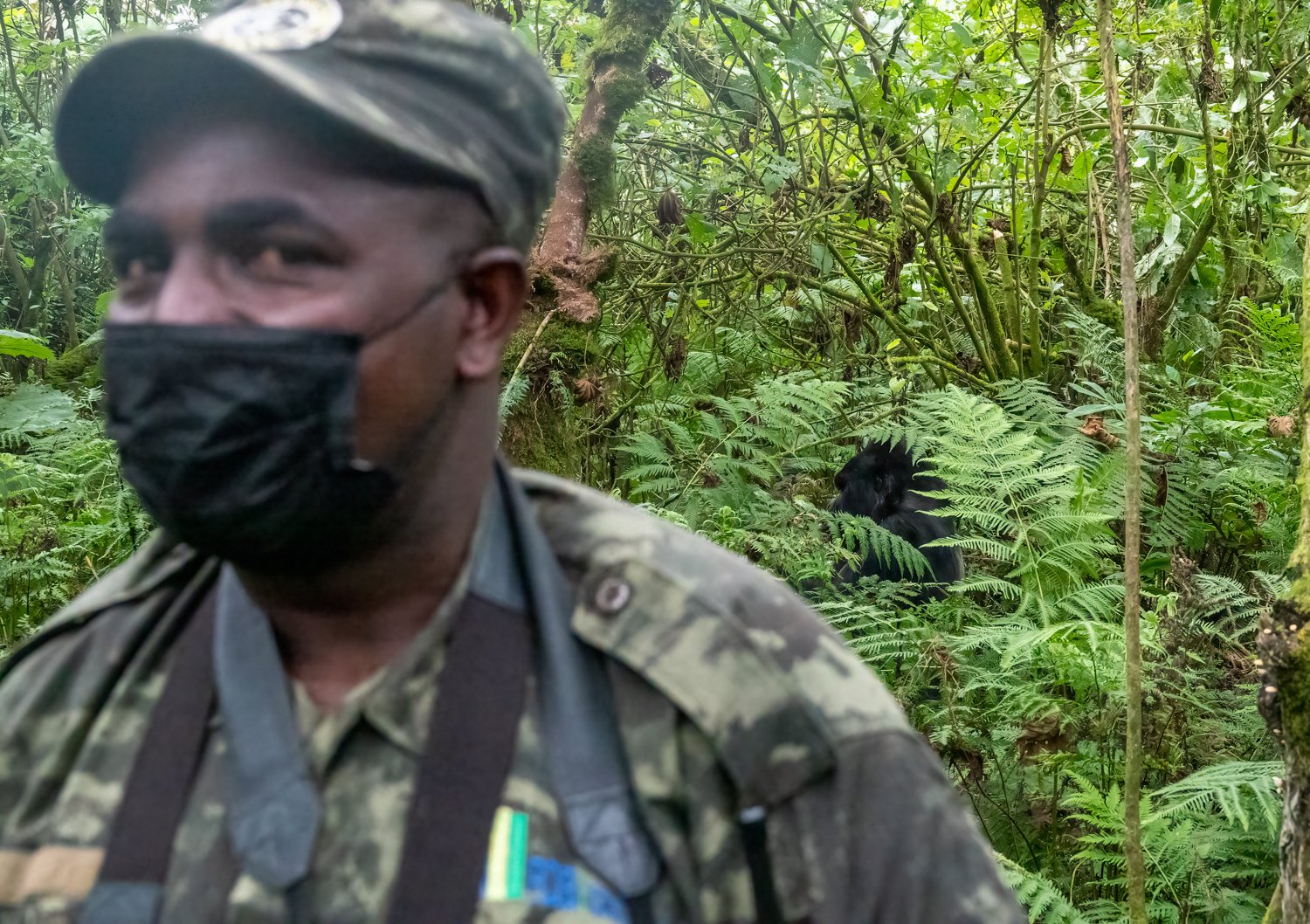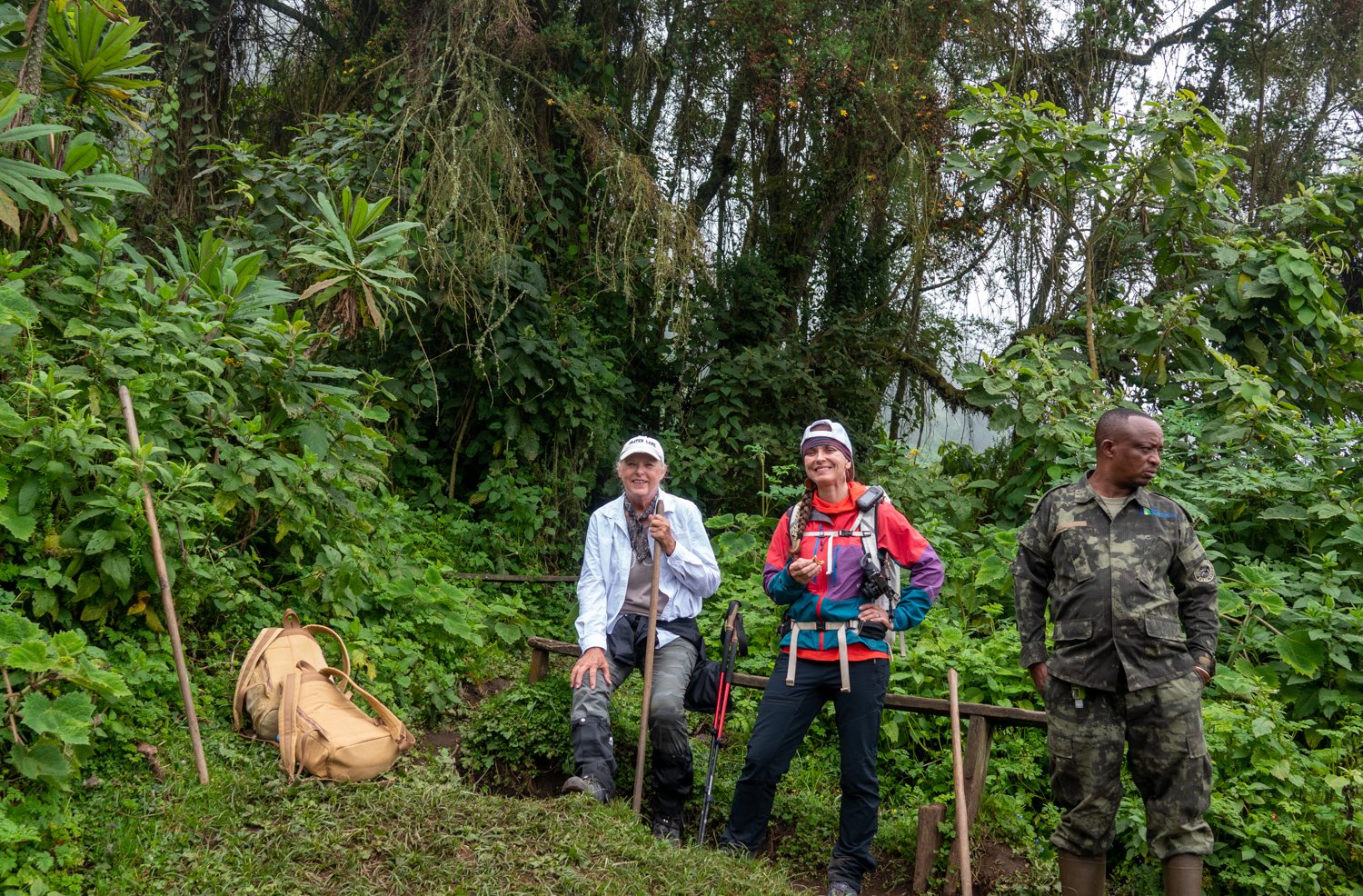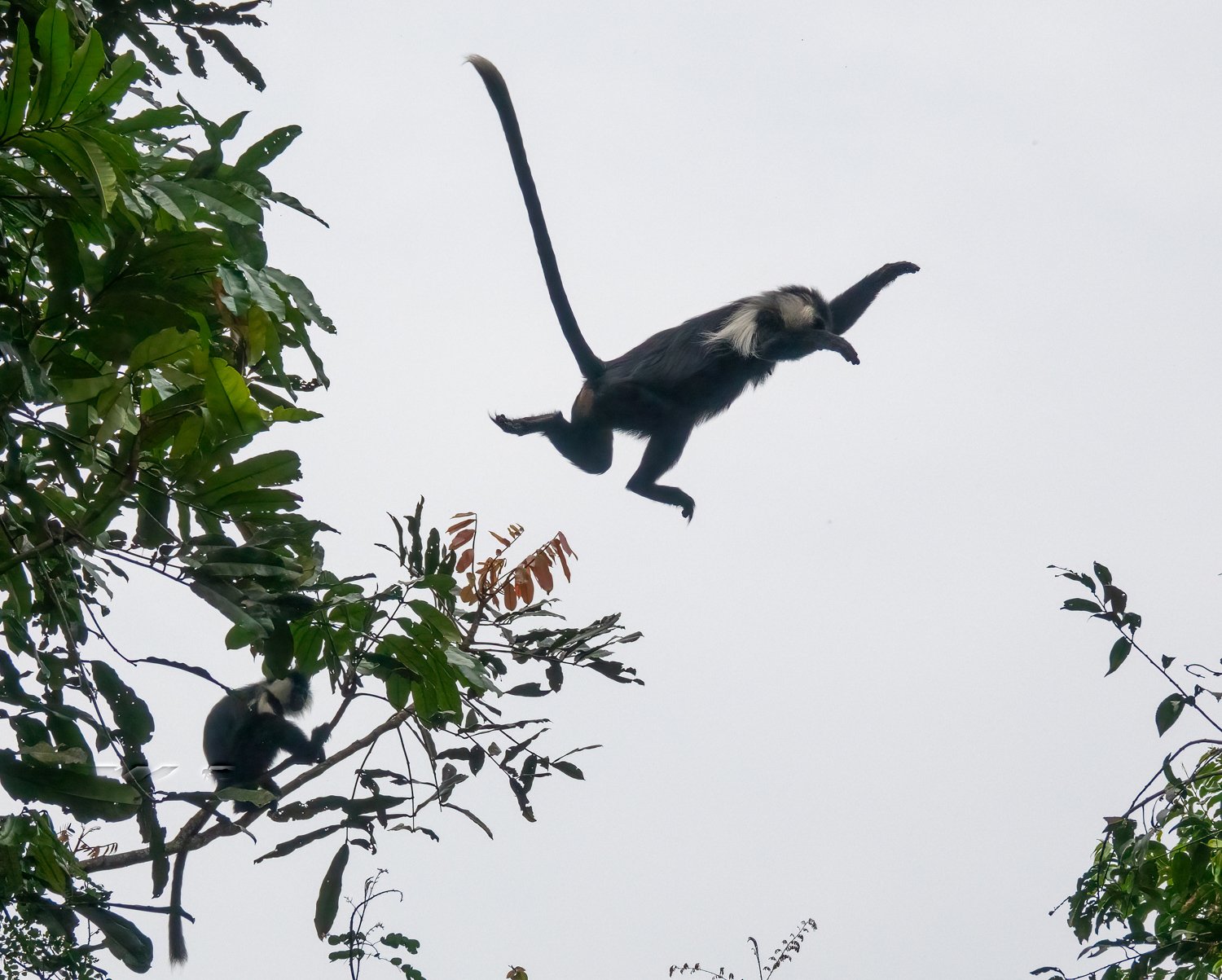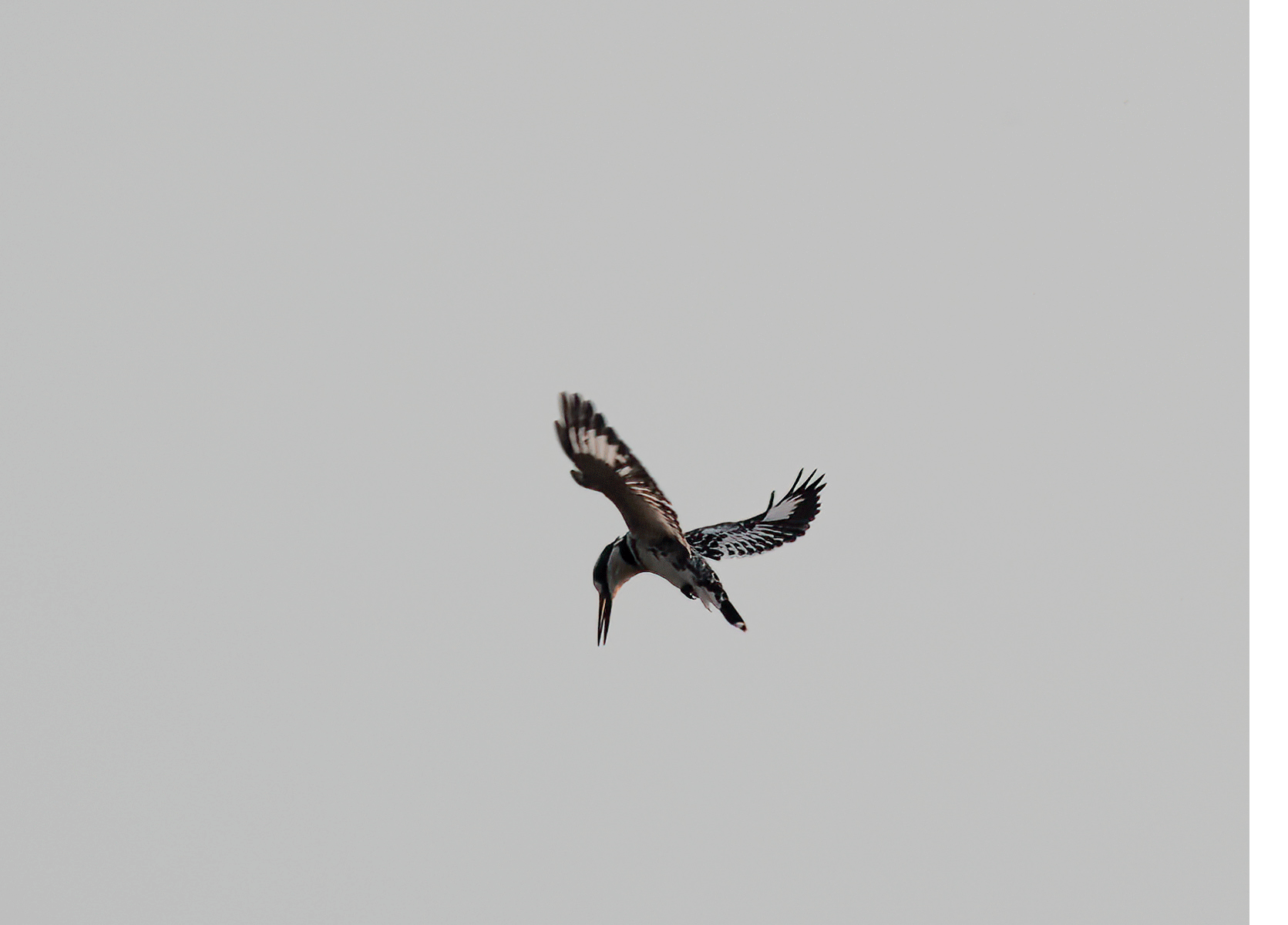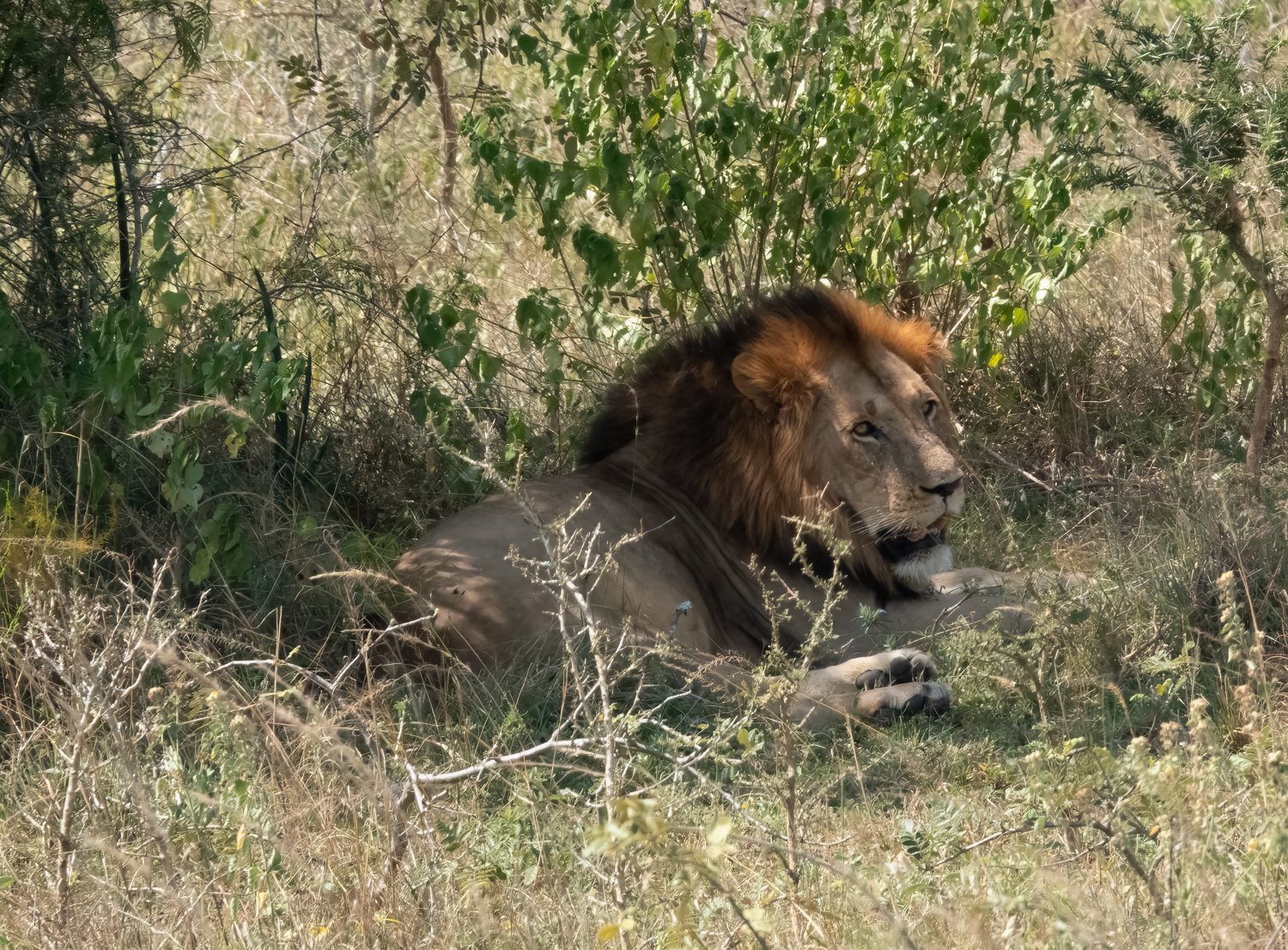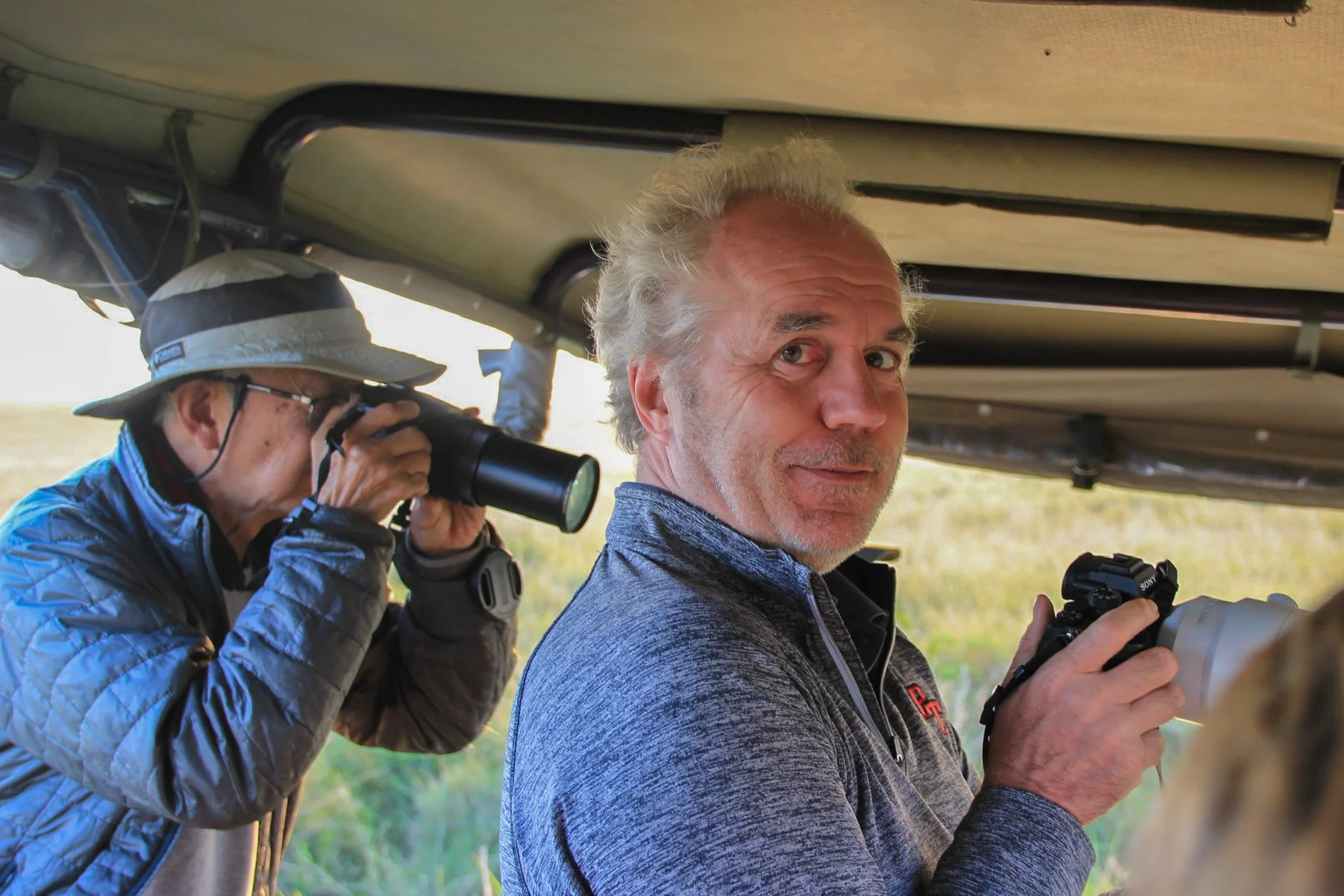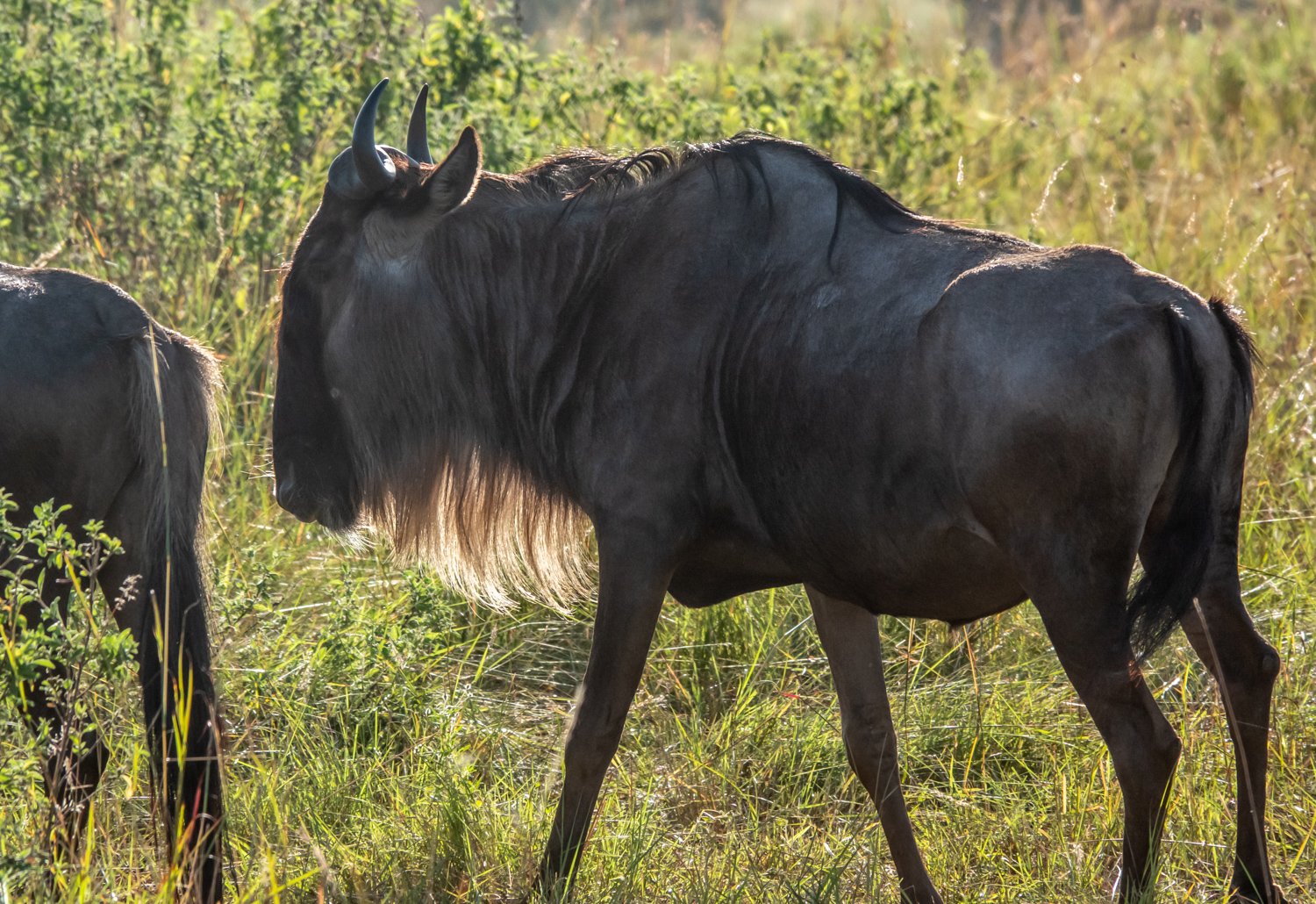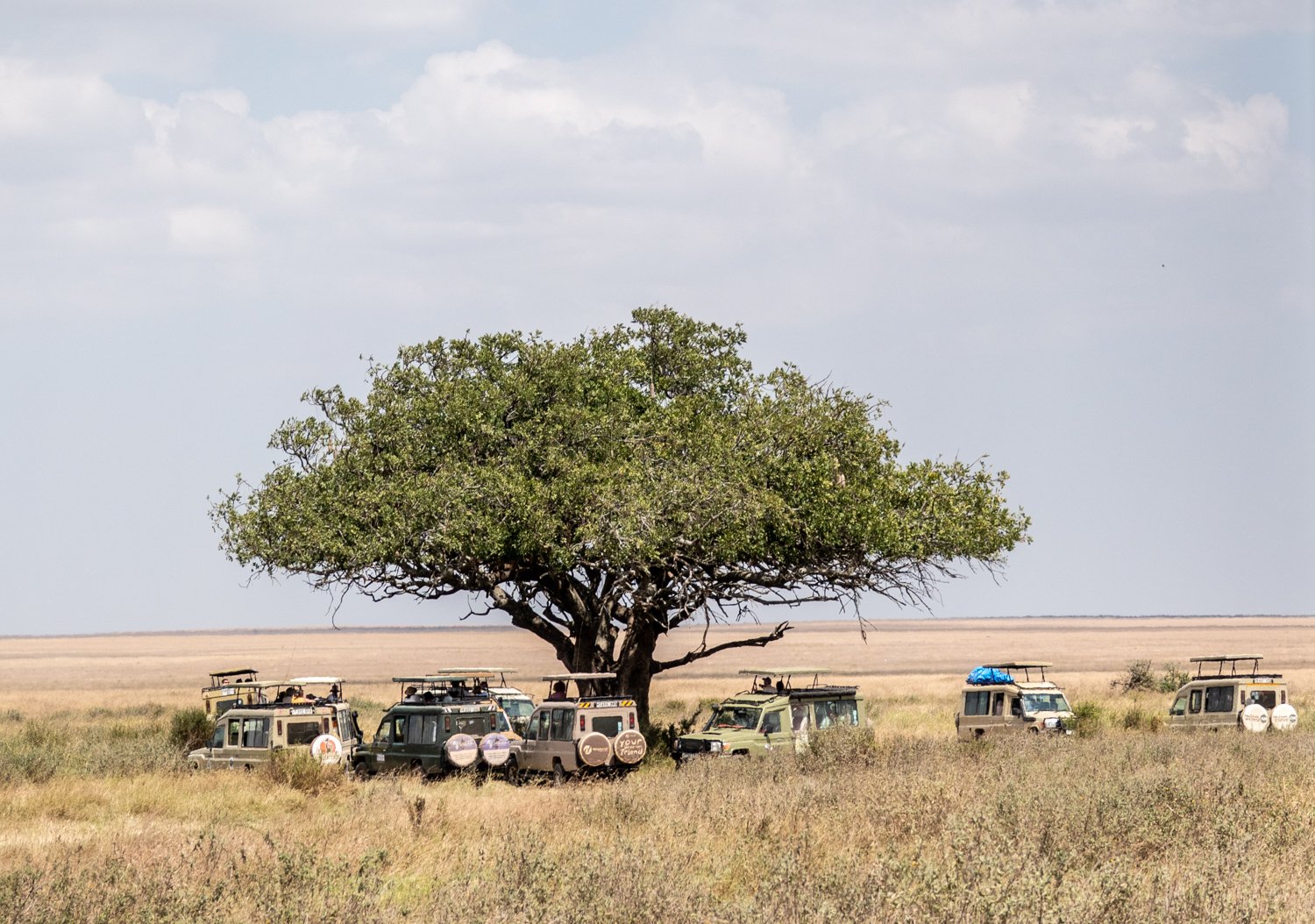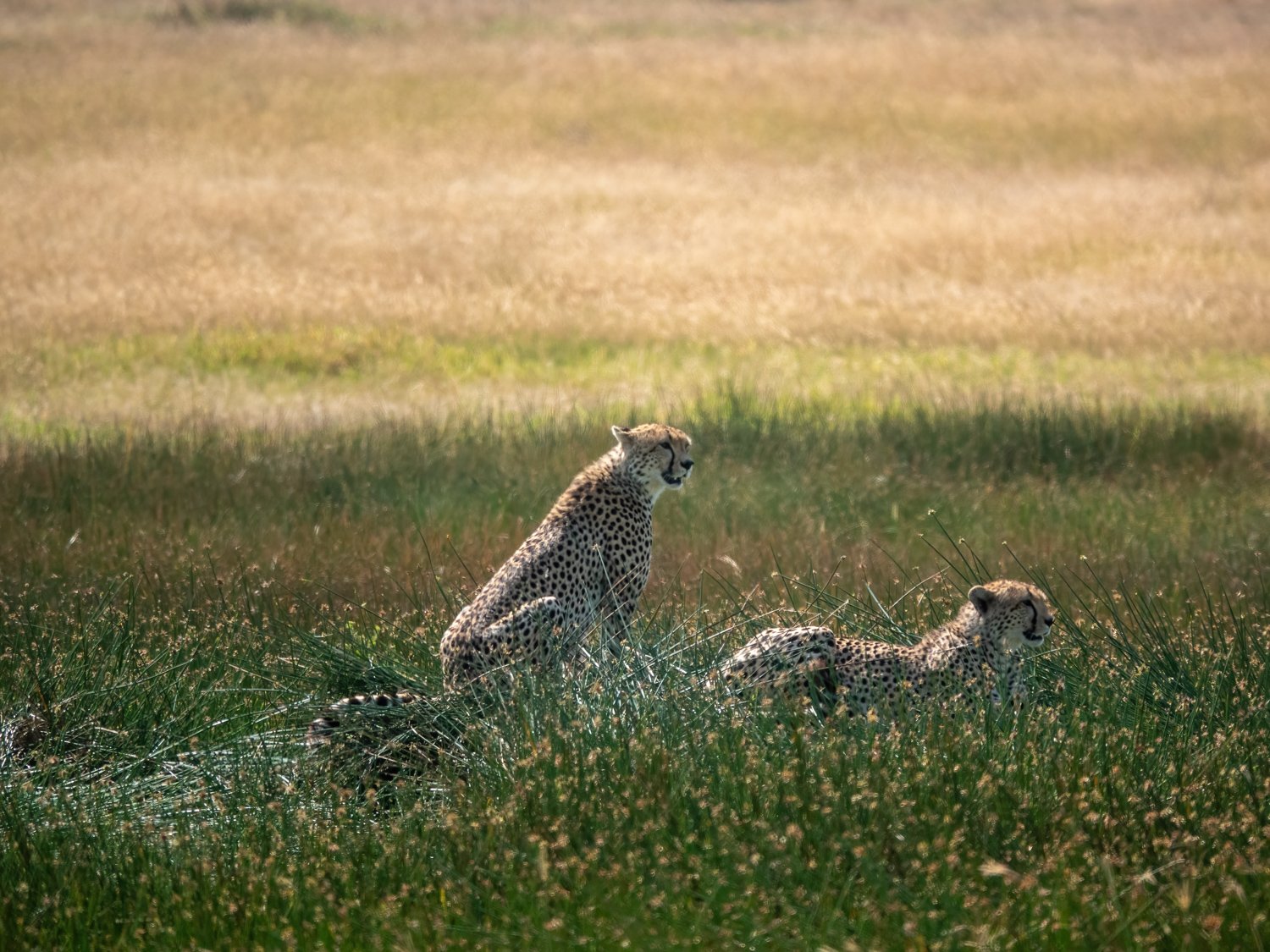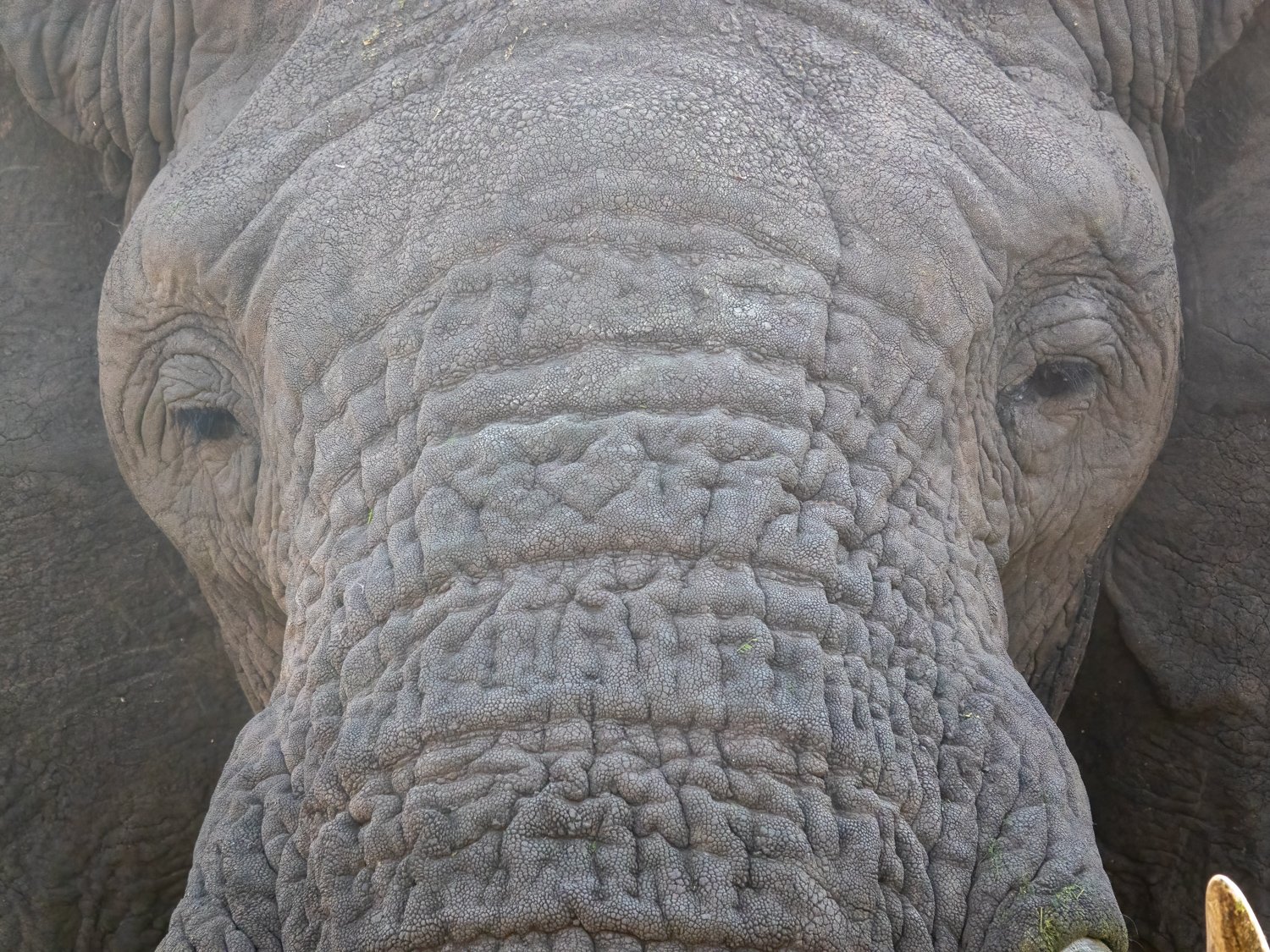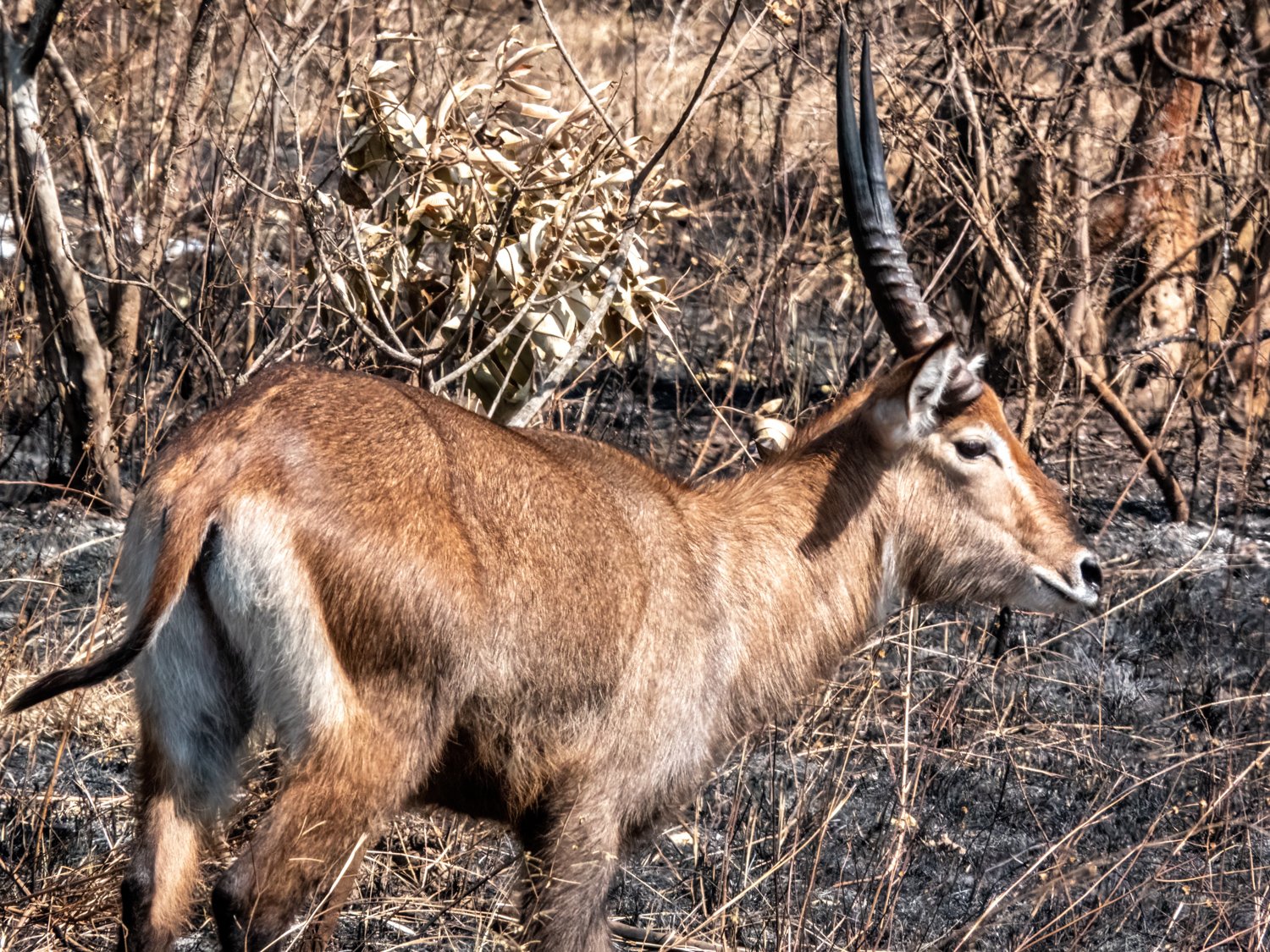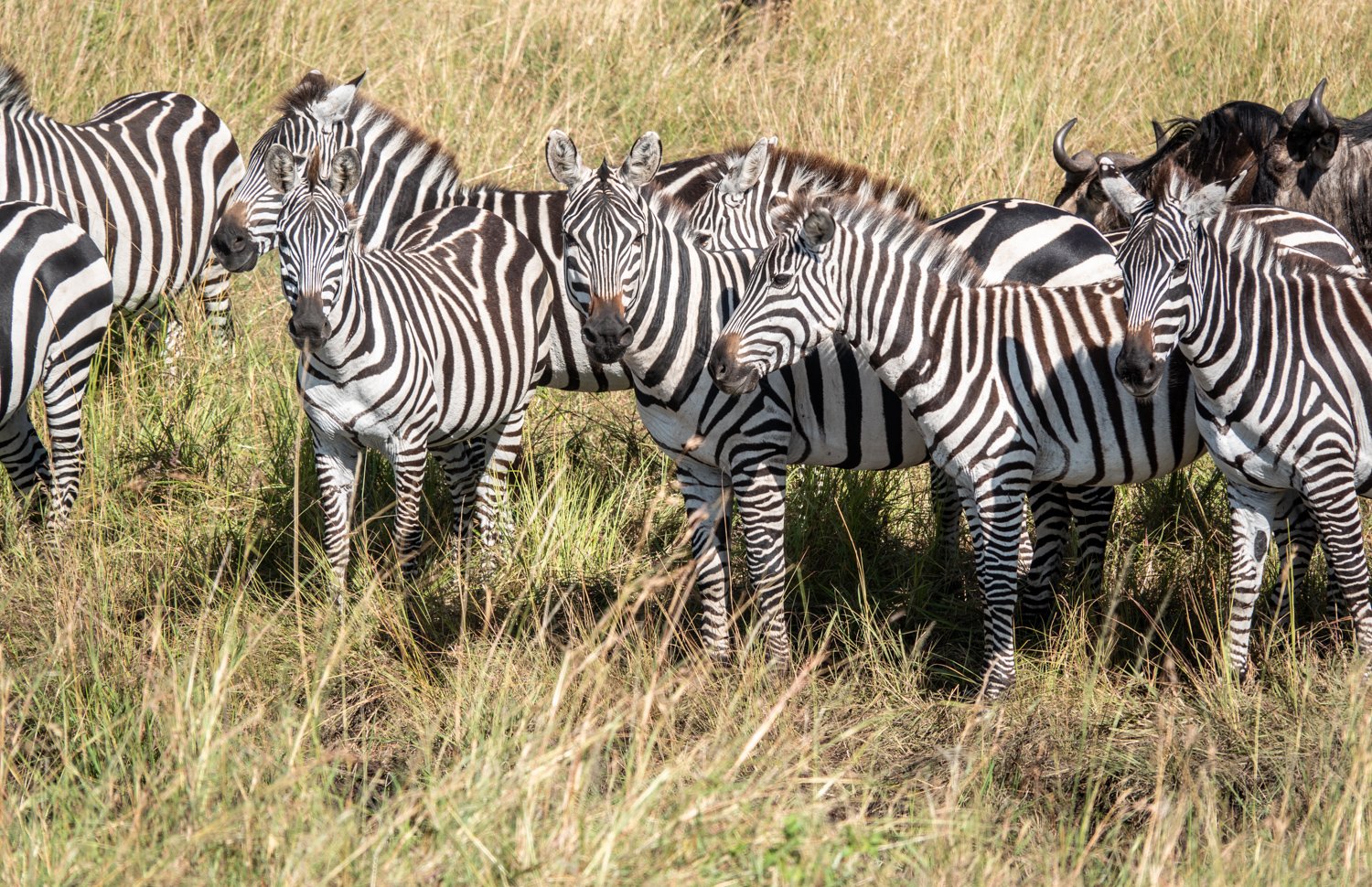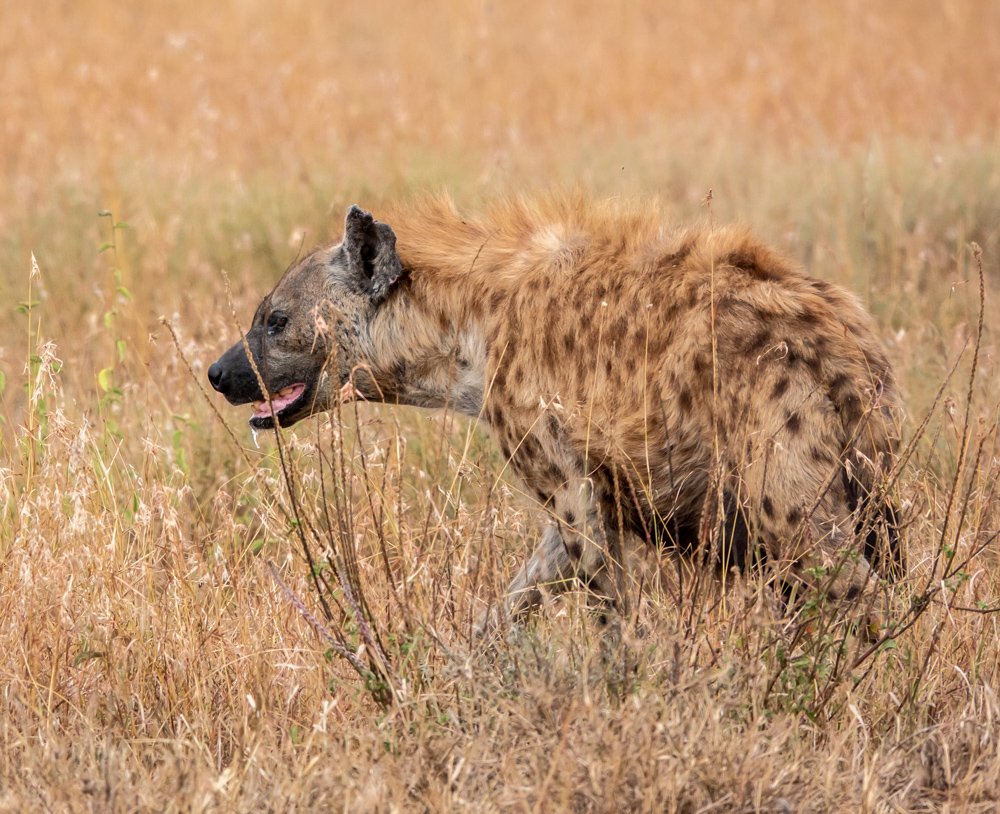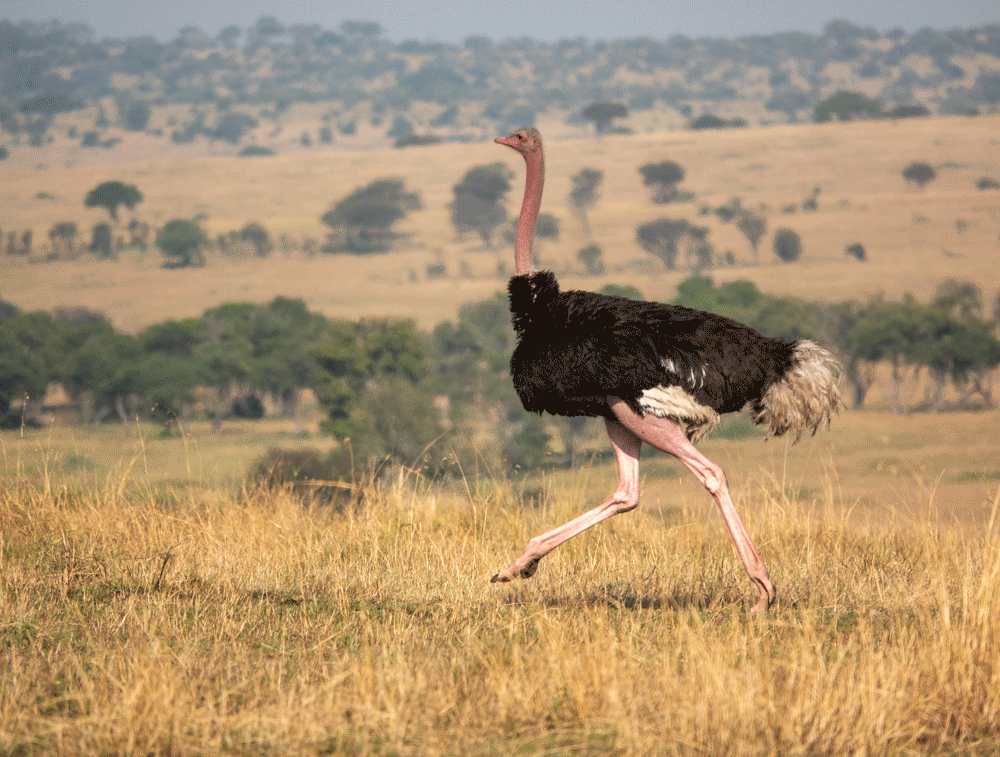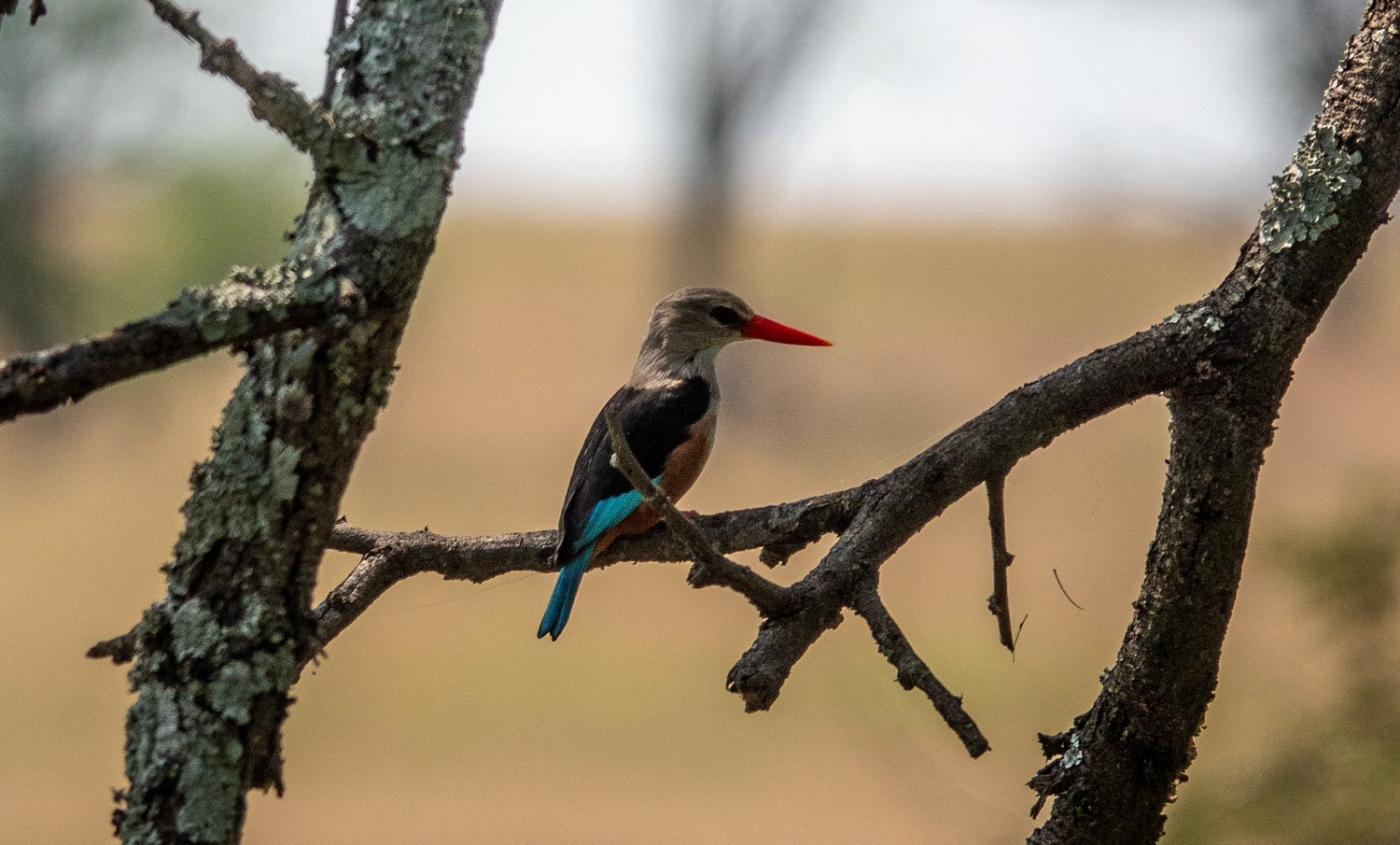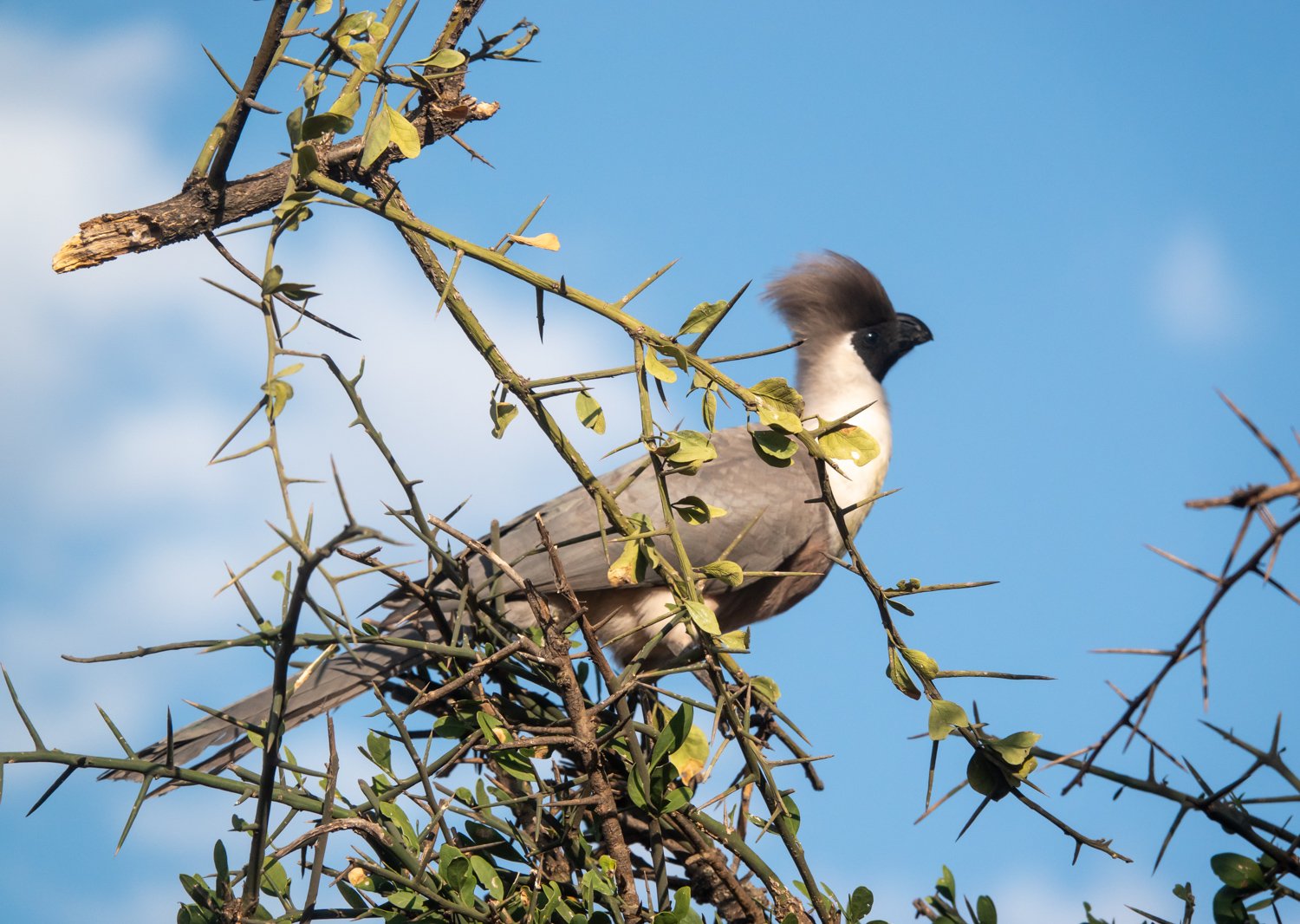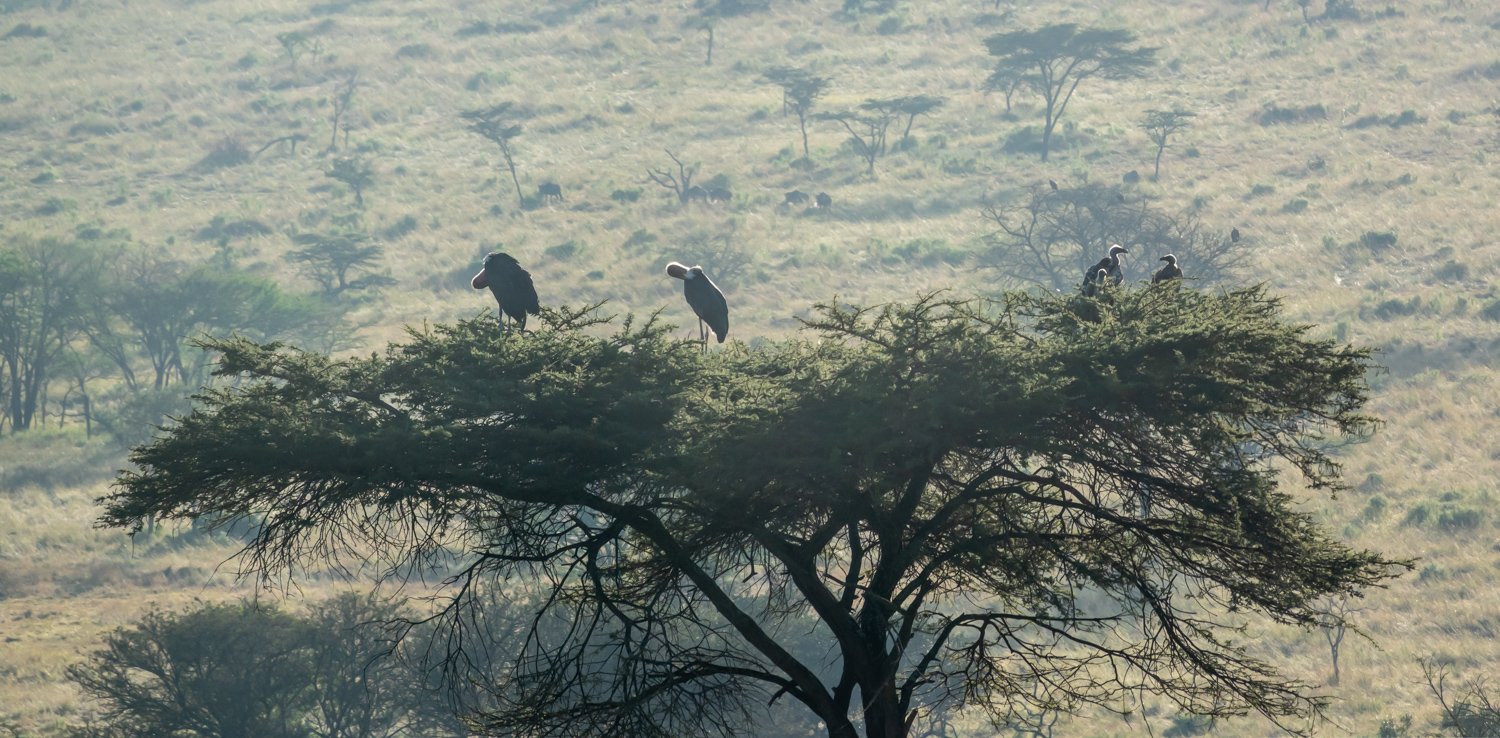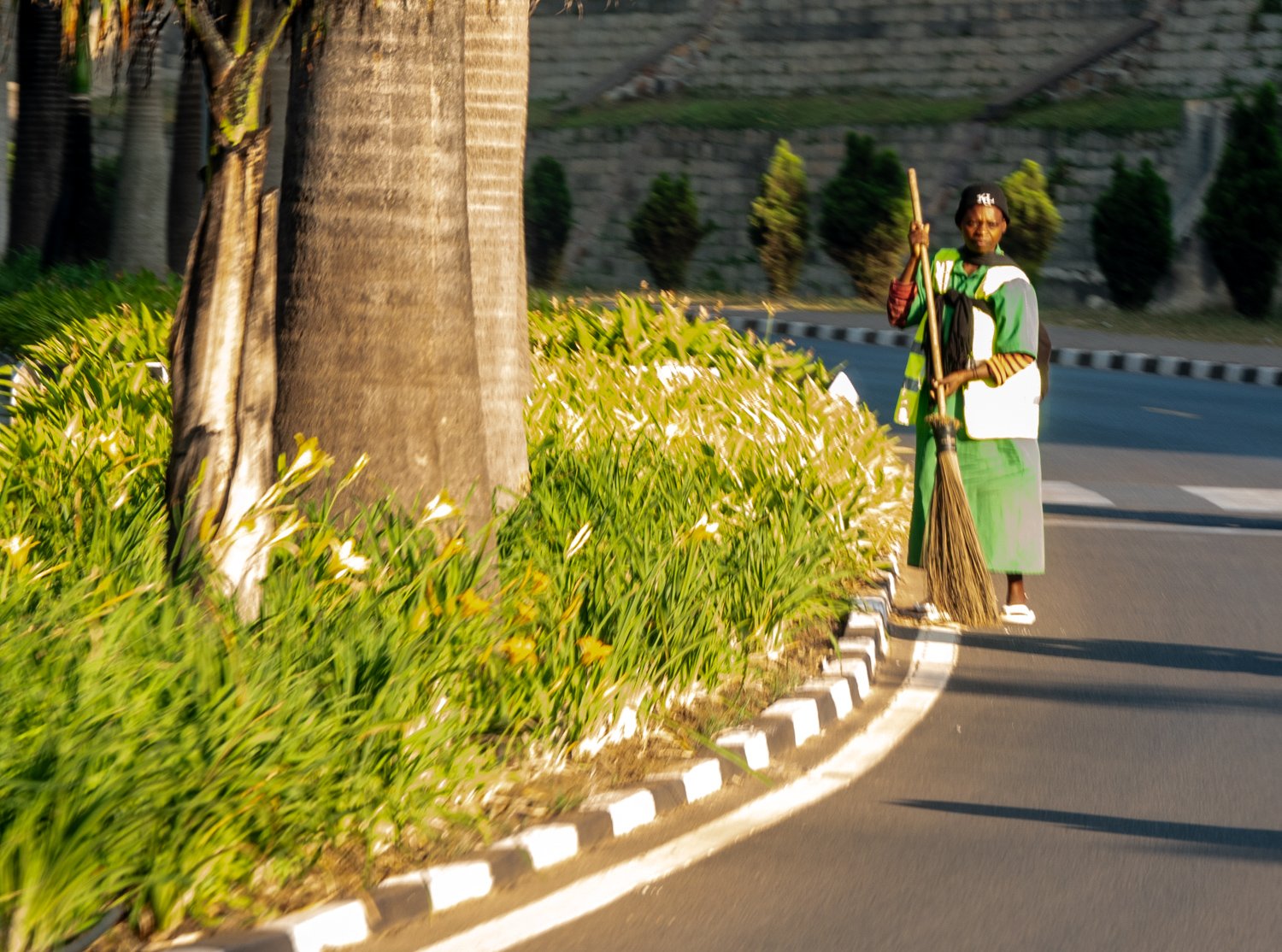Africa
In July 2023 I went to Rwanda and Tanzania for my first trip to Africa. The impetus for this trip was to go gorilla trekking in Rwanda. Last summer I discovered that one of my friends in Madison is the sister of a noted primatologist, Amy Vedder. She and her husband Bill Weber have written a book, In the Kingdom of Gorillas: The Quest to Save Rwanda's Mountain Gorillas, on their experiences in Rwanda, initially working with Dian Fossey. They were instrumental in developing the concept of using ecotourism rather than military combat, which Fossey favored, to fight the poachers who were decimating the mountain gorilla population. I contacted Amy and she gave me the name of one of their former guides, who works for the Rwanda Ecotours company. He set up a 10-day tour of Volcanoes, Akagera and Nyungwe National Parks in Rwanda. He also put me in touch with their sister organization in Tanzania, Maasai Wanderings, for a 10 day safari to the Serengeti National Park where I stayed in two different safari camps.
If you would like to hear the stories behind many of the photos and videos in this blog, I gave a Zoom presentation to the Photo Midwest Third Thursday talk on June 19, 2025. The presentation was recorded and is available here. It includes photos of my trip to Borneo to trek with orangutans.
Map of Rwanda and Serengeti
Small world experience: meeting my friend Tom Zinnen from UW-Madison in the airport bus in Brussels. We both had on color coordinated t-shirts from UW Science Expeditions albeit from different years. He and his wife were on their way to Senegal.
Rwanda Ecotours arranged a detailed trip in Rwanda, beginning in the capital city of Kigali. I had previously researched African safaris but had found the experience overwhelming, in that it was impossible to decide what to do and where to go. This was much easier: I just trusted Amy’s advice so all I had to do was pay the money! I had planned to arrive in Kigali a day early so I could get over jet lag and see some of the sights. However, my flight out of Madison was delayed so long that I would have missed the flight to Brussels. So I left the following day from ORD after taking the VanGalder bus in the morning to avoid having to depend on a morning flight from Milwaukee, which as it turned out was indeed also delayed.
I was met in Kigali at the airport by my personal Rwanda guide, Peter Freeman, with whom I would spend the better part of the next 10 days. The next morning we departed for Akagera National Park in northeast Rwanda for 2 nights, then we returned to Kigali for one night and drove to Nyungwe National Park for 3 nights before going to Volcanoes NP for 4 nights. I will not tell the story in temporal order and instead start with the gorilla trekking experience.
My guide Freeman and I at the end of my tour in Rwanda. He was an excellent companion for 10 days.
Volcanoes National Park
As the name implies, the park is dominated by 5 extinct volcanoes (Gahinga, Sabinyo, Bisoke, Karisimbi and Muhavvura) that sit on the border between Rwanda and Democratic Republic of the Congo. The gateway to the park is the city of Musanze, or formerly Ruhengeri, which is now full of tourist lodges to accommodate the highly successful gorilla trekking business. I stayed in the Five Volcanoes lodge.
Gorilla trekking
Studies of gorillas began in earnest with the seminal doctoral work at the University of Wisconsin of George Schaller whose resulting publication, The Mountain Gorilla: Ecology and Behavior (1963), was fundamental to the subsequent and more well-known studies of Dian Fossey, whose research station in Volcanoes National Park is now the center of gorilla trekking in Rwanda. Fossey’s work, highlighted in her book and movie, Gorillas in the Mist, successfully put the critically endangered primates at the forefront of ecological consciousness. During Fossey’s research the numbers of gorillas were dropping precipitously such that the expectation was that they would be extinct by the turn of the century. Native poachers were killing all of the adult gorillas in a family to capture young babies for lucrative sales to zoos and for food (bush meat). Fossey’s approach to battling the poaching was to hire militia to shoot the poachers. This was a war that she could not win. In 1979 the Rwandan government had plans to sell vast swaths of the national park for commercial development since the gorillas couldn’t be saved.
At this critical juncture Bill Weber and Amy Vedder, who came to Rwanda in 1977 to work with Fossey, played a seminal role in demonstrating how gorilla trekking could be a much more sustainable strategy to the poaching problem. They helped, against Fossey’s advice, to set up the Mountain Gorilla Project. They showed that gorilla families could be acclimated to short visits by strangers and that these strangers were willing to pay big bucks for the chance to look a silverback and its baby in the eye. Current fees in Rwanda are $1500 for a one hour visit. Both Bill and Amy also got their bachelor and doctoral degrees from UW-Madison, so there is a close connection to my home town. An important aspect of Bill and Amy’s work was to educate the local Rwandans on the value of the gorillas. Now they are proud of the gorillas and work to protect them. Schaller credits Bill and Amy for establishing gorilla tourism as a conservation success story.
Now over 40 years later the success of the gorilla trekking strategy is evident in the multitude of tourist lodges in Musanze, the millions of dollars of revenue generated by the program, the Rwandan government’s decision to widen the protected areas of the park for gorillas, and, most importantly, in the increase in the number of the once highly endangered gorillas. The graph below shows the best estimates of the mountain gorilla census in Volcanoes National Park from Schaller’s initial estimate of 400-500 in 1960, to the steep decline to about half that number in 1980s, and the slow recovery to over 600 now after gorilla trekking was established. In the 1980s there were many experts who predicted that the mountain gorilla population in Rwanda would be extinct by 2000, so this is one of the best stories of the success of ecotourism.
There are now 28 gorilla families in the Musanze area, about half of which are acclimated to the one-hour/day visits by gorilla trekkers. While the permits to visit the gorillas is quite expensive, it is clear that the money is going toward helping to sustain the animals. The guides, trackers and porters, who are supported by the permits and tips, are locals who now appreciate that the welfare of the gorillas is critical. Previously, many of them might have been poachers who killed the gorillas. Now gorillas are valuable to their own livelihood and they work to protect them. The government is also very supportive in providing armed guards to protect the whole enterprise. So, signing up to go gorilla trekking is an excellent option for anyone who wants to support these invaluable animals.
Every morning all of the trekkers and their guides assemble at the Volcanoes National Park Headquarters where the trekkers are assigned to visit specific gorilla families. Since the gorillas wander around the jungle from day to day, it is important that trackers first find each of the families so the trekkers can be led to them. The terrain is thick jungle and mountainous so hiking to the gorillas can be challenging. Presumably, they try to match the trekkers with their hiking ability. My guide asked me what kind of hike I preferred. Since I had just done a rather strenuous hike to Karisoke the previous day, I didn’t see any advantage to going on a difficult hike. As a result, I believe, and because of my advanced age, I was assigned to an easy hike as there were several in my party who had difficulty just hiking on level ground, let alone through the jungle. The porters assigned to our group made sure that everyone was secure, though one person did stumble and fall into a nettles plant which required some first aid. We were fortunate in that the weather was dry and the ground was not muddy. We visited the Kwitonda family..
My guide Freeman seemed to know everyone of note. While waiting for the assignments to be made, he introduced me to Prosper Uwingeli, Chief Park Warden of the park. When I mentioned that I had come to Rwanda on the suggestion of Amy Vedder, Prosper told me that he knew Amy and Bill well and was very complimentary about their contribution to setting up gorilla trekking. Likewise, my guides for the gorilla trek, Daniel, and for the golden monkey trek, Emmanuel, also knew Amy and Bill and asked me to send them their regards.
On the left is the director of the gorilla trekking in Rwanda, Prosper Uwingeli, with Mt. Sabyinyo in the background.
Our guide Daniel for the gorilla trekking with Mt. Gahinga in the background.
Bushwhacking through the jungle to find the gorillas
We hiked about a half hour before getting to the gorillas. Each family is led by a male silverback who is an amazingly powerful specimen. Undoubtedly it could easily kill or severely injure a human with one blow. However, they really seem to be peaceful creatures. One of Fossey’s seminal contributions was to work out methods to make the gorillas comfortable in the presence of humans. Whenever the silverback was moving about, our guide Daniel would make some low gutteral sounds that are apparently comforting to them. We were not supposed to interact with the animals in any way but on one occasion a young gorilla actually touched me as it was making its way through the line of humans, who were all facing the other way to watch the silverback. Basically all the gorillas seemed busy on foraging for food and ignored us, though they kept an eye out.
Stripping the outer skin before eating the tender heart of the plant.
The guide at lower right gives a sense of how close we were to the gorillas
Youngster eyeing the visitors.
You don’t need a long lens!
The silverback high up in the trees.
The silverback
The silverback up a tree
Note on viewing the embedded videos
Unfortunately viewing the videos successfully appears to depend very much on your internet speed. In my limited experience, it needs to be >50 Mbps to load properly.
In the video below of the gorillas climbing a tree, note that the mom is carrying a baby gorilla on her descent.
The silverback and a young gorilla.
Karisoke
I also spent a day hiking to Karisoke, the site of Dian Fossey’s original research station located on the saddle between the volcanoes Karisimbi and Bisoke. The buildings and grounds were completely looted and destroyed during the Rwandan genocide of 1994. All that remains are Fossey’s gravesite as well as the gravesites of some of the gorillas she studied, including that of Digit, her favorite. The hike to Karisoke is strenuous and probably the least interesting of all the hikes on my African trip but I had friendly companions on the hike. And since I had read a lot about Karisoke it was interesting to see it in person.
Hiking to Karisoke
At the gravesites of gorillas studied at Karisoke, next to Fossey’s grave.
My hiking companions to Karisoke, Elysabeth and Joan. (photo taken by Elysabeth)
Golden monkey trekking
Another activity of great interest in Volcanoes NP is to go trekking for golden monkeys (Cercopithecus mitis kandti, not to be confused with snub nosed golden monkeys) which are found solely in the East African mountains. These unusual and adorable monkeys live in large groups of up to ~100 and they seem to spend most of their time voraciously devouring leaves and vegetation. The trekking group was much larger for these monkeys than for the gorillas, but the monkeys did not seem distressed by having a large group of cameras and cell phones pointed at them. Occasionally they would leap from one tree or bush to another and I was fortunate to catch one in flight. This was much more difficult than catching the colobus monkeys (see below) in flight because it was less predictable.
Look out below!!
One monkey nearly stepped on my shoes as it whizzed past me.
Welcome to the Jungle!
In the video below our guide for the golden monkeys Emmanuel entertains the group. He was much better with discussing the monkeys than he was at recalling the lyrics of the, apparently, famous Guns ‘n Roses song. He was also a friend of Amy and Bill.
Nyungwe National Park
Chimpanzee trekking
Nyungwe National Park is located in the southwest corner of Rwanda. The attractions of the park include chimpanzee and colobus monkey trekking, as well as a rainforest canopy walk. I stayed in the Top View Hill Resort. At the time we were there, the giant fig trees were full of ripe fruit and the chimpanzees were gorging on the feast. So pretty much the entire time we spent with them, they were not moving much except to pick off the figs and spitting out the seeds and skin while sitting high in the branches.
All of the chimpanzees were high up in the fig trees gorging themselves. This one was the alpha male.
On the trail to the chimps
Our chimp trekking group photo. There were trekkers from Mexico, Switzerland and the USA in our small group.
Canopy walk
Colobus monkey trekking
Ironically with all of the preparation to trek with gorillas and chimpanzees, my favorite primate trekking experience turned out to be watching a troop of colobus monkeys making their way through the jungle in Nyungwe. On this trip I was the only trekker and was led by 2 guides and 2 trackers. Part of the search for the monkeys required hacking our way through the dense foliage with a machete. But it was definitely worth it as the acrobatic leaps were astonishing, circus-like in character.
Bushwhacking to get to the colobus monkeys
After observing the monkeys making their way through the trees, I soon discovered that I could sometimes predict when they were going to leap from tree to tree and was able get shots of the colobus flying through the air. It was astonishing that they would always find a safe landing spot. My guides said that they had never seen one fall even though their leaps can be up to 50 feet! Apparently the hands of colobus monkeys are unlike all other monkeys: they do not have thumbs. In fact their name derives from the Greek ‘colobi’ which means mutilated. However, it is believed that this adaptation makes it easier for them to grab on branches during landing. Their long white mantle and bushy tail also help to act as a parachute to slow things down.
To add to the difficulty of the monkeys making their way through the jungle, several moms were carrying babies as they were leaping!!
There were several mothers who did acrobatic leaps with young in tow
Here I am trying to capture the flying monkeys. Shot by one of the guides using my cell phone.
Other mammals in flight
In addition to the monkeys, the impala antelope also has spectacular jumps. In some cases they seemed to jump straight up into the air though it was difficult to catch on ‘film’.
Male impala with his harem
Other flying mammals
From Nyungwe, we drove up the coast of Lake Kivu and stayed overnight at Kibuye. In the morning I took a boat to visit a large colony of fruit bats (Eidolon helvum) or flying foxes on Nyamunini Island (or Napoleon Island for the resemblance to a hat). The colony roosted in a grove of trees. When we walked under the canopy it stirred the colony up into the air.
Akagera National Park
Our first trip from Kigali was actually to Akagera National Park, on the eastern edge of Rwanda. I stayed at the Ruzizi Lodge in a tented cabin that overlooked Lake Ihema. The first day we arrived in time for lunch which was served on the patio overlooking the lake. While eating lunch, I was surprised by a sudden splash and the appearance of a hippopotamus surfacing for air. It turns out that the lake is full of the large beasts, but what a surprise for lunch!
Lunch spot, but at sunrise
My lunchtime companion
While driving around the park, I spied a pied kingfisher perched on a branch. It then took off and hovered over the water for a moment before dive bombing for a fish.
Pied kingfisher on a perch…
Hovering …
Banking…
Diving…
Hippopotamus
What’s the most dangerous animal in Africa?
The mosquito, because of the threat of malaria.
However, of the large animals there are more human fatalities by hippos than by any other animal. My guide Freeman thought that hippos were dangerous because they kill for the fun of it, not for food, as they are vegetarians. Perhaps one reason they are so dangerous is that they are much faster and more mobile than they appear. Shortly after we had this discussion and I was properly warned about keeping hippos at a distance, we were waiting near the boat dock for a boat ride on Lake Ihema. Suddenly I heard something crashing through the bush and heavy footsteps. Two hippos were thundering up from the lake, passing about 20 yards from where I was standing. Fortunately they were chasing each other and did not pay attention to me. It was certainly impressive to see how fast they could run. I was so surprised by the sudden encounter that I didn’t have time to set my camera focus or focal length properly as they came rumbling past me.
Close encounter with a hippo
Later I joined a bunch of other tourists for a boat ride on Lake Ihema where we saw many more hippos, birds and other wildlife.
African fish eagle
Goliath heron (Ardea goliath)
Darter
Cormorant taking off
Glossy ibis atop papyrus plants
Sunrise at Ruzizi Lodge
On the first day I was still jet-lagged from the long plane ride, I woke up early so I wandered out to see the sunrise. There were many flocks of birds waking up and flying out to their day perch. As I was trying to catch a shot of sunrise with the flocks of birds, I noticed a cormorant in the water and was able to zoom in and catch it with breakfast.
Sunrise on Lake Ihema. This is the shot I had in mind when I arose at dawn. Then I noticed a bird on the water (see below).
Cormorant with breakfast at sunrise
Baboons
Hyena
Warthog
Denizen of Mara River
Papyrus plants along the shore
Elephant and lion
Rhinocerous
Serengeti National Park
After the visit to Volcanoes National Park, I flew to the Kogatende airstrip in Tanzania into the northern Nisikia Mobile Migration camp of the Serengeti National Park to join a tour from Maasai Wanderings. While the parks in Rwanda were typical jungles, the Serengeti is wide open plains. Indeed, Serengeti means ‘endless plains’. The first camp was situated near the Mara River and the herds of wildebeest were migrating towards the river. However, we were several days too early to see them cross the river. After 4 days I flew south to the Seronera airstrip in the central Serengeti to the Little Moru camp. Since the experiences in the two camps were similar, I will describe the trip by the wildlife seen. Each day was a safari in a Land Rover sometimes targeting a particular animal, sometimes with others but usually by myself with a guide.
The endless plains
One’s experience in the safari is heavily dependent on your safari guide. I had excellent guides throughout Africa, indeed in the northern camp my guide Mohamed (Moodie) Sufian was a photographer who had published a book on sunset scenes in the Serengeti. He is also an expert on the physiology, anatomy and ecology of the region.
Going off-road with Moodie
Our guide Moodie in Serengeti giving an anatomy lesson on the skull of a cape buffalo to me and my safari companions, the Bott family.
Martin Bott and myself, as captured by his son Max
In the Serengeti, especially, finding the wildlife can be problematic. The guides rely on the network of other guides, sometimes with a central radio contact. All the conversations are in Swahili so I never knew what was being discussed but sometimes the outcome of a discussion would be a detour to some spot where an animal was sighted. It was not uncommon for oncoming safari trucks to stop for a brief chat, presumably relaying what they had just seen but sometimes apparently just swapping some gossip. Clearly it is in their best interest to be on good terms with all of the other guides and I had a couple experiences that confirmed this.
One day after we had driven for several hours in the central Serengeti without seeing much, there came a report on the radio, and my guide suddenly went off-road across the plains. Sure enough we soon saw a pair of cheetahs near some other safari trucks. However, on the way there we fell into a rut and could not get out despite the 4 WD. After several unsuccessful attempts, my guide stopped trying and spoke to someone on the radio. He reassured me that “Help is on the way” and would arrive soon. I was a bit dubious since there weren’t many other trucks in sight, except the ones near the cheetahs, and it seemed unlikely that AAA would be available. But a few minutes later a truck appeared driving across the plains where we had just been. It came up behind us and gently pushed us out of the rut. With barely a nod to acknowledge the help, my guide then proceeded on to view the cheetahs, much to my relief. Several days later we found ourselves in a similar situation, with the same result.
Wildebeest
In many ways the dominant animal of the Serengeti, especially during its migration, is the wildebeest. In sheer numbers they represent 1.5 million individuals all moving continuously as the seasons change. In some places they are in herds that stretch almost as far as the eye can see. I imagine that the American plains buffalo were once in these numbers, stretching from horizon to horizon.
Backlit wildebeest
Wildebeest and zebras are often found together.
Serengeti tableau: wildebeest, zebras and ostrich.
Wildebeest stampede: I took this photo at a slow speed to try to convey the chaos of the stampede when the jeep track crosses the path of the herd.
The Big Cats
Lions
The other dominant animal in the Serengeti is the lion. It was the most common big cat I encountered during the safaris. All of the tented safari cabins had strict rules about having assistance whenever you leave the cabin at night. So if you had to leave your cabin after dark to check your email where there was WiFi in the reception tent, you had to blink a flashlight to signal someone to come and accompany you outside. Same when you needed to return to the cabin. And it was not uncommon to wake up to hear lions roaring at night.
Lioness surveying the menu options.
Lioness stalking in the grass
We counted over 20 lions in this pride
A tender moment
On the lookout
Lion and lioness in early morning with a camp building in the background. This is why one doesn’t wander around alone at night.
Shot before sunrise, lit by flashlight. Another reason to be cautious at night.
Lioness nursing her cubs in the shade
As we all know, kids are a problem, especially when they are young and helpless. The apes and monkeys take care of the problem by having the young cling continuously to the mother, even when she is flying through the trees. Obviously, this can be stressful to the mother. But the solution for the predator cats seems even worse: they have to leave the cubs in the den or on the savannah when the mom has to go hunt. This is far from ideal as the cubs are very vulnerable when mom is not nearby. Compare the facial expressions of the cubs in the photos below when the mother is nearby and when she is gone hunting.
Lion cub waiting for mom.
Waiting anxiously for mom to return.
With lunch
Just looking for some shade
Disgruntled lioness
On the prowl
Leopard
I did not see many leopards and those I did see were usually asleep. In the heat of the day leopards find a place to snooze, often up in a tree where they attract a crowd even if barely moving.
Leopard sleeping in a tree draws a crowd
Cheetahs
I had good fortune to have several long exposures to the magnificent cheetahs while they were doing something interesting. We even came upon one with a freshly killed young wildebeest though we missed the action by about 15 minutes.
A cheetah cub
Young cheetah cubs waiting for mom.
Cheetahs attract a crowd.
Keeping watch
My guide thought we were about 15 minutes late to see this kill.
The endless plains of the Serengeti
This is a small cat, the serval.
Safari staff entertainment
Apparently it’s traditional for the staff at the game lodges to greet the guests when they arrive every afternoon at the end of the day’s safari. Often there is a cool refreshing drink of juice as well as a towel to wipe off the day’s grime. The videos below show our greeting at the Nisikia Mobile Migration camp in the northern sector of the Serengeti as well as at the Little Moru camp in the southern Serengeti..
Elephants
Perhaps the most interesting animal of all in the Serengeti is the elephant. Usually found in a herd of 10-15 often with young animals in tow. We were fortunate to come across a herd of elephants crossing the Mara River, which is filled with crocodiles and hippos.
Getting a drink from the Mara. Note the hippopotamus in back, left.
Practicing for the big top.
Young elephants roughhousing
I did not realize how much elephants like to eat trees, wood and branches as well as leaves. With their bulk and agile trunk they play a significant role in shaping the Serengeti savannah as seen in these videos.
Wisdom
A Fibonacci spiral?
There was only one time when we experienced an animal that was clearly upset by our presence. We were watching a family of elephants slowly crossing the road. After most of the herd, including some young ones, had crossed, one elephant suddenly started running towards us with ears flapping and head swinging. My guide immediately backed the truck up to get out of its way (which made my video recording unstable). The elephant gave a loud snort as he crossed in front of us and was still visibly agitated. For what reason we could not fathom.
With this exception and with the exception of wildlife that were on or near the road when we drove by, during almost all other encounters the wildlife treated us as if we were not there.
Giraffes
Another charismatic animal with a lot of interesting characteristics. They are hard to miss when looking across the savannah. Interesting that their long tongues are prehensile.
The long neck is handy
Young giraffes training for neck-to-neck combat
A giraffe pair having fun
Oxpecker bird on host
Often times the giraffe appears rather awkward as it’s walking or running. And with limited agility it seems unable to forage easily, but its long and prehensile tongue manages much more than one might expect. When feeding on leaves in a tree, the tongue will grasp the leaves and pull them off, even if the tree has sharp thorns, as in the photo below.
The tongue is also essential for drinking water.
Cape buffalo
Another candidate for most dangerous animal on the savannah is the cape buffalo, which travel in large herds. They look mean and seem easily irritated and bad tempered. Indeed on one of the gorilla treks in Rwanda, we heard that a trekker was gored by a buffalo that unexpectedly came out of the bush. The trekker had to be taken to the hospital.
Life and death on the Serengeti
Other wildlife
Before I came to Africa, just about everything I knew about the wildlife derived from watching The Lion King. So it was interesting to encounter almost all of the same characters at one time or another.
Hartebeest antelope
Waterbuck
Topi
Zebra
Hyena
Hyena
Rhinocerous
Black-fronted duiker’s antelope
Langur monkey
Warthog
Dust devil
Baboons
Hyrax
Ostrich running on the endless plains of the Serengeti.
Ostrich mating dance
Entertaining the curious buffalo
Hippos in the Mara River
We’ve got your back…
Snake (python) in the grass
Waiting in the Mara
Klipspringer
Black-backed jackal
Birds of Africa
The birds that one sees on safari in Africa are almost, though not quite, as spectacular as the mammals and reptiles. While it may seem like there are animals where ever you look, this is only true in a small number of places. Much of the time, there are wide open plains in the Serengeti with no wildlife in sight or dense jungle where you can hear a lot of activity but see nothing. When the mammals are not apparent, then one notices the birds, which are wonderful. Since a bird sitting on a perch often does not show its beautiful coloring, I tried to get shots of the birds in flight as well. Obviously, this is much more difficult but often more rewarding.
Grey headed kingfisher
Superb starling
Von der Decken's hornbill
Lilac-breasted roller bird
Sometimes you get really lucky and get the one in flight and on the perch in the same shot.
Green woodhoopoe
Yellow-billed stork
Saddle-billed stork (Ephippiorhynchus senegalensis)
White-headed buffalo weaver bird
Bare-faced go-away bird
Blacksmith lapwing with chick
Blacksmith lapwing
Black-winged stilts
Cinnamon-breasted bee-eater doing its thing
Chasing an insect in the air
Marabou stork
Vulture
Black crake
Three banded plover
Ruppell’s starling
Bateleur eagle
Secretary bird (Sagittarius serpentarius) living up to its name
Secretary bird with light snack
Southern ground hornbill
Hamerkop
Hamerkop nest
White-rumped shrike with lunch
Cormorants
Speckled mouse bird
Purple grenadier
Crowned lapwing
The crowned lapwing has unusual nesting behavior. Basically it lays its egg almost anywhere on the plains with little sign of a nest. When they do so on the road, then inevitably a car or truck will run over the nest and egg. So safari guides will construct a rock surround to discourage cars from driving over the egg. When approached while incubating the egg, the lapwing will maintain its position until the last possible moment and then fly to the side and feign injury to try to draw attention away from the egg.
Crowned lapwing sitting on its egg. It was reluctant to abandon the egg as we approached but finally did so. This nest was on the shoulder of the road and the rocks were placed there by guides who wanted to discourage cars from driving over the nest.
Another crowned lapwing’s ‘nest’ (egg is at center of photo). This one was off the road and was spotted by my guide because he saw the bird fly off this spot as we approached.
A crowned lapwing hovering over its egg on its ‘nest’
Crowned lapwing in flight
Safari staff entertainment
On my last night at the Little Moru camp in central Serengeti, the staff gave us an extended bout of entertainment. I’m sorry that I can’t understand the words. I’m sure it would be even more interesting. I’m guessing that they are going through the menagerie of Serengeti animals.
Kids of Africa
In Rwanda many of my trips involved driving over seemingly impassable bumpy roads in a 4 WD passing through small villages. Of course, the children would all come out to see what was coming down the road since that was probably going to be the biggest event of the day. I soon discovered that if I waved to the kids, they would invariably give me a big smile and wave back.
On the chimpanzee trekking tour in Nyungwe several of the trekkers brought along material (fruit, small toys) that they distributed to the children who gathered to meet us.
Stephane brought along a bag full of goodies that he distributed to the kids
Street scenes in Rwanda
Since I lost my extra day in Kigali due to the airline snafu, it limited my exposure to everyday life in Africa. Most of my experience was just seeing the street scenes as we drove to our destinations through the villages of Rwanda.
One very striking and surprising aspect of Kigali and Rwanda was the cleanliness of the streets. After experiencing the utter disregard for disposing trash properly in Nepal, I was surprised to see how orderly the streets in Kigali were. In fact, you would be hard pressed to find a single piece of garbage on the streets and sidewalks of the city. Try to find a piece of trash in the accompanying street scenes. At daybreak there are people out in the streets sweeping up the trash, which is actually mostly leaves and grass, not man-made garbage. The Rwandans are renowned and proud for their cleanliness. My guide said that once a month there is a National Cleanup Day when people are expected to participate.
Sweeping up the streets at sunrise
Typical street scene in the rural areas of Rwanda: few cars or trucks but many bikers and pedestrians carrying wares.
Ferrying full 20-liter water containers uphill by bike. If full, each container weighs about 45 lbs!!
Ferrying 20 liter water containers by bike (empty now).
I always felt sorry for the bikers when we passed people on bikes with heavy loads as they walked their bikes uphill. But it turns out that it may be even more difficult for them to do downhill. On the long downhill stretches in mountainous Rwanda, the brakes on the bike cannot be relied upon. So bikers will drag the bottoms of their sandals on the pavement to act as a brake.
We followed this biker for several minutes along a downhill stretch of road and he dragged his right sandal for the entire time. Freeman said they sell special sandals with thick soles for this task.
Going to market carrying goods the old fashioned way.
Ferrying furniture by wheelbarrow.
This woman was working in the fields with her baby. She was happy to greet us
Transporting furniture by bike
Bananas are a common bike transport commodity
Hitching a ride
Carrying goods the old fashioned way
Going to the market day
Or see video here Market day in Rwanda
African sunrises and sunsets
Giraffe family at dawn
Please note: All text and photos are copyrighted to Tom Yin. You are welcome to share the URL, however re-production of text or photos is not permitted. If you would like to feature this story, contact me and I would be happy to provide you with details, photos, text etc. Thanks!





















